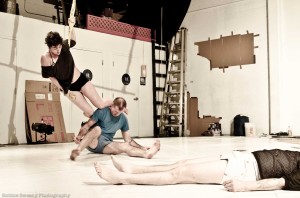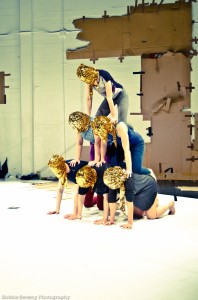By Kate Mattingly
A couple days before leaving the Bay Area at the end of June I saw Keith Hennessy’s Turbulence (a dance about the economy) at CounterPULSE. In many ways it seemed a fitting farewell: I had spent the last year in the doctoral program in Performance Studies at UC Berkeley and many hours of seminars and conversations explored relationships between performance, activism, and engagement. Outside the classroom, I admired the unceasing innovation and integrity of Bay Area artists I watched in events at Yerba Buena Center for the Arts, CounterPULSE, ODC Theater, Dance Mission Theater, The Garage, and KUNST-STOFF. San Francisco seemed to cultivate a sense of exploration and fearlessness I had not grasped in years I spent in New York, Washington, DC, and cities throughout Europe.
The highlight of my coursework at Berkeley was a seminar called “Social Practice” taught by Dr. Shannon Jackson, author of 2011’s Social Works. In this book she states “It is my contention that some socially engaged art can be distinguished from others by the degree to which they provoke reflection on the contingent systems that support the management of life. An interest in such acts of support coincides with the project of performance.” In July, as I settled into a new home on the east coast, thoughts about Hennessy’s Turbulence continued to percolate, and I wondered what went into his process and what the future holds for his distinct way of challenging, in his own words, his “ignorance about financialization.” I sent questions to Hennessy as he traveled in Europe and suggested a multiple-voiced interview with emailed responses from him as well as performers/collaborators. Ultimately Hennessy and Julie Phelps replied. Here are their answers to questions about Turbulence, which will be presented at YBCA September 27 to 29.
Kate for In Dance: What were the collaborators’ perspectives on the economy at the outset of Turbulence? Keith has written “I set out, over two years ago, to challenge my own ignorance about financialization, about the roots of economic turbulence, and to sharpen my understanding and critique of extreme wealth disparity.” What were the performers’ perspectives on financial structures and did the piece shift (or how did the piece shift) your understanding of the economy?
Keith Hennessy: The piece has been a vehicle or an excuse for learning more and more about banking systems, debt, capitalism, corporate personhood, the corrupt and unjust relations between governments and corporate power/interests/profit, the issues of de/regulation, and variations of boom and precarious bust in several countries (from which our collaborators come from). Some of this learning has been social, that is, in the context of shared readings, public and private salons, shared personal narratives, and rehearsals. And some has been an increased attention to the news and recent literature and film responding to the crash of 2008 and its aftermath.
Julie Phelps: The economy is cryptic, and probably intentionally designed to be as such. Even still it is difficult to not have a very personal relationship to it, outside of ‘understanding’ it. To say that I was ignorant about the financialization or the economy more broadly is a sort of avoidance that is not satisfying. That is, it forgives or sidesteps the ways that the economy is designed to be opaque and seem beyond personal control, inviting us to forget that it is actually impossible for us to avoid the real effects of the financialization of our daily life.
At the outset of Turbulence I knew little of the causes of the economic effects that I saw all around me – people out of work, people losing their homes, people going to prison on drug charges. This project has been truly educational in some of the moving parts of the economy and how it has led to vast wealth disparity and real violence. Yet, it remains a rabbit hole of sorts – the more you think you know the more you realize a certain level of incomprehensability. However, there has been something empowering in my inevitable failure to understand, releasing me into my instincts and my body and my dreams of alternatives.
Kate for In Dance: It was interesting to read that your engagement with Turbulence preceded the Occupy movement. How did Occupy influence Turbulence and vice versa?

Keith Hennessy: I participated in and/or followed more closely the Occupy actions and uprisings in Oakland, Davis, Berkeley and San Francisco while maintaining an overall view of national, European (indignados…), and Canadian movements. I am moved and inspired by the growing consciousness that rejects some basic capitalist assumptions. And I was especially inspired by the fierce responses to nationally orchestrated police violence. Running from the fumes of poisonous gas and seeing the bleeding body of Iraq vet Scott Olson minutes after he had been shot in the face, I joined thousands in the streets of Oakland who refused to disperse. It felt so good returning over and over to confront the cops while insisting on our right to protest corporate ‘occupation’ of our financial, insurance, medical and educational institutions. There’s nothing like a police riot to efficiently reveal the interconnections between police and corporate interests. And when over-reactive violence did not stop the movement, universities, cities and states have rushed to create new laws limiting even further our rights of free speech and public assembly. And meanwhile the actual criminals, the ones who actually stole or manipulated legal loopholes to gain insane personal wealth, and continue to be indicted by activists and journalists, continue to run the banks and every government commission and think tank created to address the crises of debt and economic collapse. Participating in Occupy has offered ongoing inspiration and education for the Turbulence project.
The silent walk of shame for UC Davis chancellor [Linda] Katehi (after she had justified the violent poisoning of students in the name of student safety!) was the best political theater I have experienced in years.
And the public forums and general assemblies I attended (including Shaping SF talks at CounterPULSE and David Graeber’s talk at CIIS) gave me a deeper political education, both in terms of economic/class analysis AND social movement tactics and responses.
Julie Phelps: The most notable influence of Occupy was the sense of being embedded within a larger conversation that both affirmed our work and promised us that we were not special in our questioning, dissatisfaction and sense of injustice. Functionally, Occupy’s hallmark decentralized model and multi-missioned agenda problematized my expectations of how we as a group should strive to make a unified proclamation or manifesto. We have increasingly decentralized and destructured our way of working, turning and returning to improvisation as a sort of anarchistic experiment to explore the tensions, exchanges, demands and supplies, and value creations that happen in between; in between individual(s) and the communal(s), between structuring and restructuring, between knowing and not knowing. Within this imaginal, but very real, space I have not come closer to ‘understanding’ the economy, but I have felt the economy, danced the economy.
Kate for In Dance: This may be a question more suited for Keith Hennessy but I’m curious how Julie responds to it also. Keith Hennessy’s last piece (that I read about extensively but never got a chance to see live), Crotch, referenced Joseph Beuys. I imagine audiences in theaters where it was presented had some familiarity with Beuys. When Turbulence began at CounterPULSE and there was the reference to Keith Hennessey [no relation to Hennessy] the former Bush administration economic advisor, it felt like lots of people had no clue who he is. With widespread ignorance in the States about the economy, do you think Turbulence shifts our understanding or knowledge of problems with the economy? Another way to ask this: what do you want audiences leaving the theater after Turbulence to know or think about the economy? Are there other outcomes you consider important?
Keith Hennessy: The project exists on multiple levels of political instigation and participation. The research process of Turbulence has been in development for 2 years and has involved over 50 artists in rehearsals and in-progress showings. Another 120 have donated to the project and over 750 people have witnessed performances of the work-in-progress in Portland, San Francisco, Vienna and rural sites in Germany and France. With each aspect of the making of the work there has been a questioning of the economy, how we are all implicated in it, what are its effects on our personal lives (or not) and what role artists and especially body-based artists might play in response to it.
 We operate as an ongoing consciousness raising group as well as an experimental performance laboratory. We are playing between a political theater that address concrete issues and a theoretical/formal project that questions the neoliberal assumptions of the theater and contemporary dance, art, performance.
We operate as an ongoing consciousness raising group as well as an experimental performance laboratory. We are playing between a political theater that address concrete issues and a theoretical/formal project that questions the neoliberal assumptions of the theater and contemporary dance, art, performance.
Julie Phelps: In a certain way I feel like I have answered this by proxy in my above responses. I think that there are some very real ‘facts’ that will be presented and absorbed by the audience, however I think the undertaking of making a ‘dance about the economy’ is that of communicating things that are not spoken or written or capable of existing in words. I can’t really think of what I hope the audience might take away except that they further understand their own relationship to the economy as a real power in the world and also an implicit force in how we build our world of relations to each other, in how we self (e)valuate, in how we exercise self policing and violence.
Kate Mattingly has written about dance and performance for newspapers, magazines, and websites. She is currently teaching graduate and undergraduate courses in dance history and criticism at George Washington University.
Turbulance runs Thu-Sat, Sep 27-29 at YBCA
Photos: Keith Hennessy Turbulence by Robbie Sweeney

